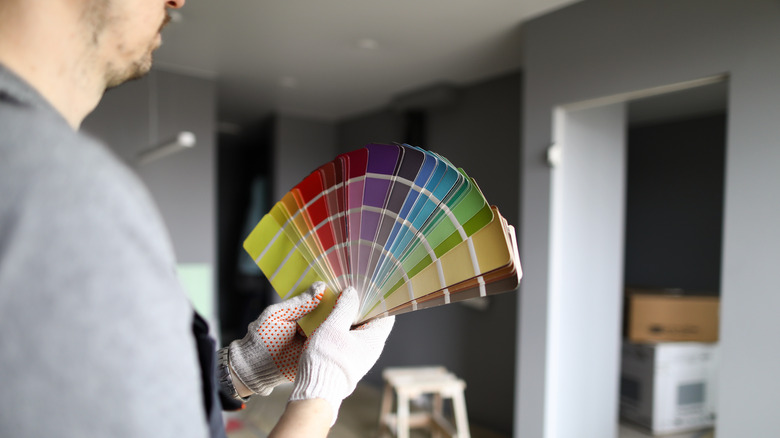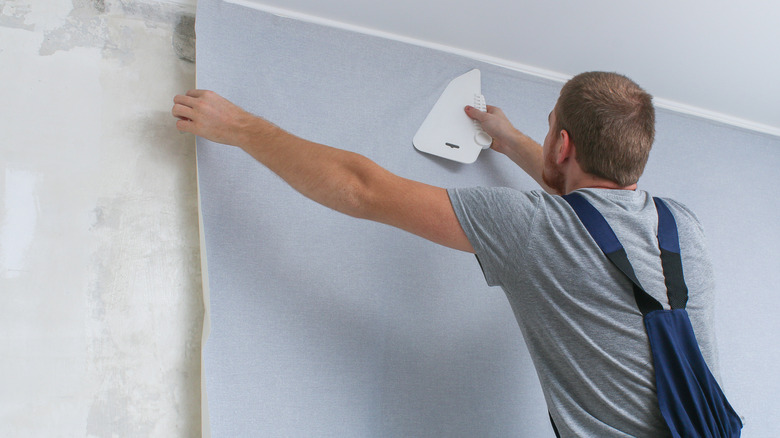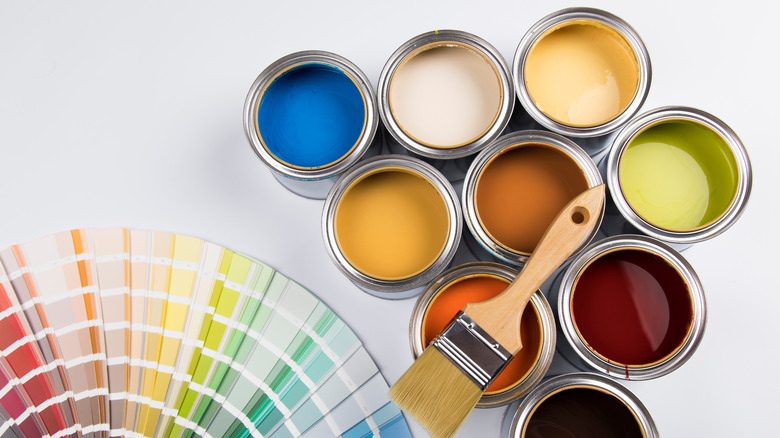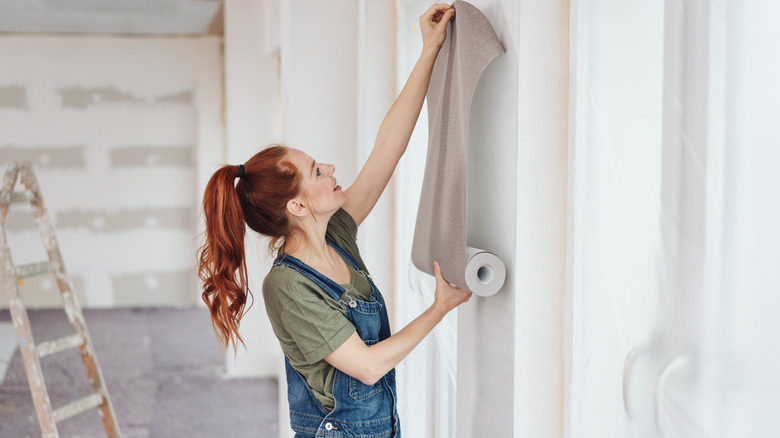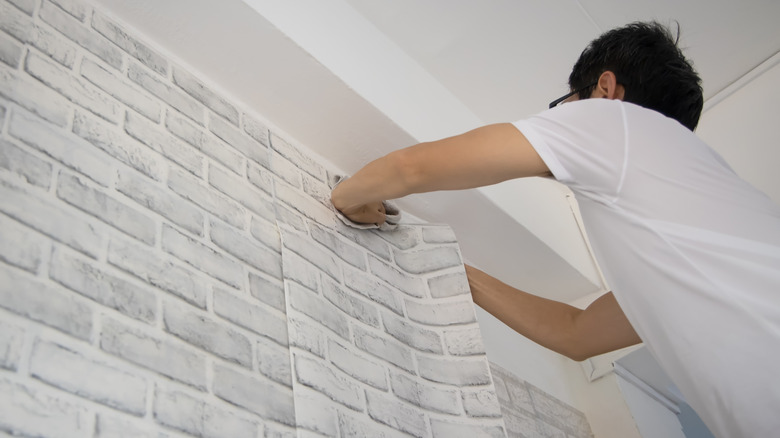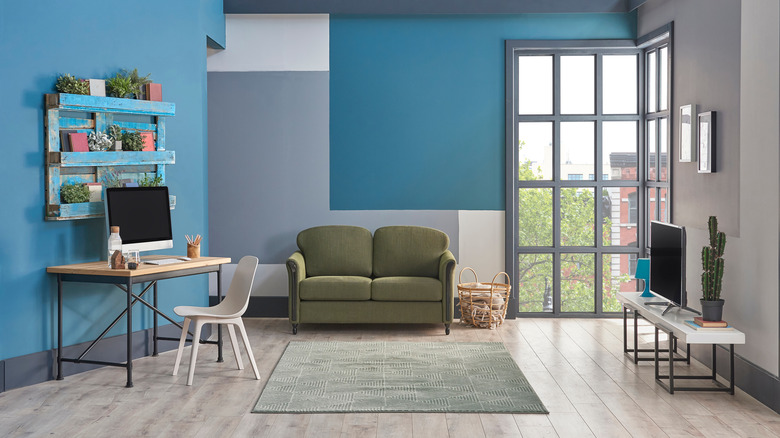Wallpaper Vs. Paint: What's The Best Option For Your Room?
Changing a room's walls is one of the quickest ways to rev it up. Remove those Winnie-the-Pooh decals from that old nursery, for instance, and swap in a bold color or geometric pattern and you'll create a home office that inspires you. But how do you decide between painting a room or using wallpaper? Before starting such a project, you'll need to assess the preparation time required, what the space dictates, how much your budget contains and the amount of work required to complete the job.
First, take a look at the area targeted for a re-design. What do the room's walls look like now? Best-case scenario is that you're starting with a white wall with no imperfections, and then almost anything is possible. Paint easily goes up without primer. No old wallpaper needs removal. You wish you get this lucky. Alas, much of the time you're dealing with the ghosts of past wall designs. As MyMove points out, taking down existing wallpaper requires time and either chemicals or stripping tools, and a careful hand; otherwise you can damage the wall. Painting, though, also needs some time to ready the project. Walls with holes or imperfections need spackle and at least 24 hours to dry. Those bright reds need a primer on top before you repaint. Most paint jobs need at least two coats of paint — and that means drying time between layers.
Still, even with any of these extra efforts, painting usually calls for less work hours than wallpaper.
What prep is needed?
While painting often requires some preparation before starting the main job, so does wallpapering. Rebel Walls warns against short cuts. "Usually we say that 75% of the overall job should be applied to preparing your walls and the remaining 25% to paint or wallpaper," they caution. For painting, that means smoothing out any uneven wall parts with sanding and spackle. Additionally, wallpapering can hide such spots like holes or marks and if you already have smooth walls, wallpapering can become a timesaver. Redecorating, though, often gives you challenges like a bright, red dining room, which you want to exchange for an almost-transparent pale pink wallpaper. This scenario would require you to paint the wall before applying the paper; otherwise the darker tint might leech through.
If your room is already papered, you must take down the old print before putting up the new, and several strategies can achieve this. You can pry the wallpaper using a putty knife or scraper to peel it off the wall. If you're lucky, your picking results in whole sheets coming off rather than rag-tag bits of paper. Still, it's rarely easy and you might require a scoring tool that allows hot water to penetrate the paper reactivating the adhesive so it loosens. Go carefully, though — if you use too much pressure, you can damage the wall. After that, you'll probably require a pressure sprayer to continue that dampening process to get all the paper off (per HGTV).
What fits the space best?
Wallpaper and paint come in a wide selection of choices. Whatever theme, color, or look you want, both techniques feature dozens of options and require you to make decisions. For paint, for instance, think about if you want a matte look or something more glossy. While glossy cleans well, the paint isn't impervious to jostling and well-traveled areas might show the chips and scratches people or things left when they hit or scraped the walls (via Real Simple). For wallpaper, you can opt for several material types including vinyl (for example, either solid or vinyl-coated fabric or paper), paper (non-woven, grasscloth, etc.), or metallic. Typically, wallpapers with vinyl keep well and are perfect for high-traffic places where the grubby hands of children touch everything (via Sweeten Stories).
Think about what will look good in the room, too: with wallpaper, for instance, should you cover all four walls, or do you want to make an accent wall to dramatize a special feature like your four-poster bed or the elegant couch, asks The Spruce. You can even attach wallpaper to the ceiling if you want to achieve a special look, like an artificial tin ceiling.
Some spaces favor paint rather than wallpaper — for instance, bathrooms and kitchens and their proximity to steam and water can impact the effectiveness of the adhesive used to secure your wallpaper, causing it to peel off. Still, if you want that look in those rooms, there are high-moisture options.
Is the price right?
While both paint and wallpaper come in low- and high-end varieties, wallpaper is usually the more expensive endeavor requiring rolls, several tools, an adhesive, and sometimes manpower to install your new look (per Bob Vila). Painting requires just a few brushes, a tray, drop cloth and tape — and is also easier to do as a DIY project, says Apartment Therapy.
Typically, according to Fixr, the average wallpaper roll costs about $30 to $50, and a 12 by 18-feet room requires about 10 rolls of paper, making the final cost between $300 and $500 if you put up the wallpaper yourself. If you hire a handyperson to do it that increases the price several hundred dollars. In comparison, the two gallons of paint needed to paint the same space is priced about $10 to $50 a gallon, with painters commanding about $50 an hour. If the average project took six hours, painting still comes in less expensive than the wallpaper renovation.
Some people might even want both wallpaper and painting. And textured wallpaper allows you to put a three-dimensional look on your wall in an understated way, and can be painted over if you desire a different color or to just want to emphasize parts of the design, according to Hunker.
How much work is required?
Usually, paint gets props for a DIY project while wallpaper application is seen to offer more challenges. Livspace even recommends that the job is best-suited for an expert since the endeavor requires patience, time, and skill.
Stripping old paper off isn't for the faint-hearted, either, and you usually cannot hang new wallpaper over old. As Wayfair explains, since vinyl-coated paper isn't porous, new layers won't stick to it well and, even if it does, mold may grow between the two sheets. Placing new over old can also highlight bumps or marks left in the pre-existing paper, especially if the first one contained any embossing or embellishments.
Painting over a wall, however, is much more simple. While it may take two or three coats to get the job done (and sometimes a primer), and requires drying time between those layers, wallpaper demands meticulousness. You must line up each sheet so the design matches perfectly while eliminating any wrinkles or air bubbles that appear during the application process. You need to go slowly or you can rip the paper, too. With painting, however, mistakes mend more easily. You simply repaint (via Home Reference).
What's the bottom line?
Whatever you choose, renovating always is worthwhile. Not only does making changes allow you to delight in upgrades, but altering your surroundings can increase the value of your home. HGTV shares that cleaning up the walls in a home makes it look updated and bright.
Plus, redecorating is fun. Think of all the possibilities you suddenly have: What color scheme to choose? What texture or pattern should the wallpaper contain? What feature of a room needs highlighting? So much goes into choosing a new room design and then enacting that plan. You can return a room to its former glory, re-envision an old bedroom into a reading lounge or a library, or just modernize an old look.
Re-creating a space gives it new life and helps you remove things that simply do not work anymore. It is an opportunity for enhancing the home and your experience in it — whether that means painting, wallpapering, or both.
